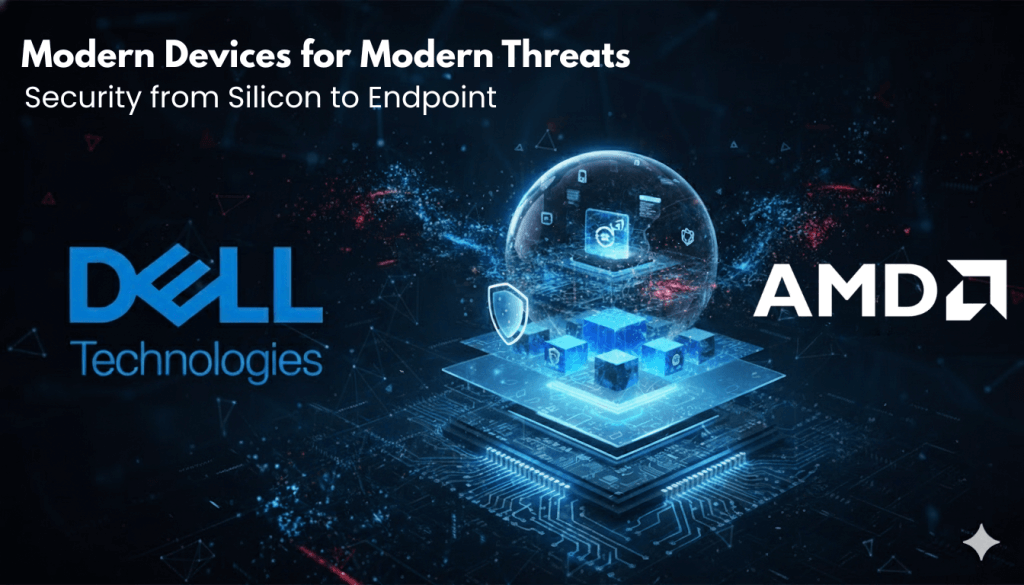
For the last decade, software has been the primary limiting factor in most technology. At the edge, that included incremental improvements in hardware processor speed, multi-threading, and memory, but the real leaps were software-defined. Today, multiple converging trends mean that dynamic has inverted and hardware has suddenly become the critical factor. The AI models that promise to revolutionize business require a new class of compute power, and this shift is happening at a critical moment: a massive wave of millions of PCs purchased during the pandemic are now due for a refresh.
This new reality was the central topic of a recent, in-depth discussion with two of the industry’s leading minds on endpoint security: Rick Martinez, Fellow and Vice President in the Office of the CTO at Dell Technologies, and JR Balaji, Director of Software Product Management at AMD. The conversation explored why this PC refresh cycle is so different, how the threat landscape is evolving with AI, and why “what you would have bought five years ago is not going to work today”.
The key takeaway is that the “software-only” approach to endpoint security is no longer enough. To stop AI-powered attacks, security must be built-in, not bolted-on, extending from the silicon all the way to the operating system and software layer.
The New Battlefield: An AI-Powered Threat Landscape
Rick Martinez opened the discussion with a stark assessment: “AI is a double-edged sword”.
Just as defenders use AI for anomaly detection, “cybercriminals and nation-states alike are
leveraging AI to scale and improve their attacks”.
This isn’t a theoretical problem. Martinez pointed to recent Zscaler research highlighting a “60%
increase in AI-Driven Phishing Attacks,” fueled by generative AI. JR Balaji noted that
adversaries have become “early and avid adopters of AI tools”. This access to AI gives them
“unprecedented scale”. This isn’t one enemy, though, threats come from all types of actors,
from nation-states to e-crime syndicates and hacktivists.
Balaji segmented this new threat landscape into two broad categories:
🔥 Weaponizing Existing Attacks
AI is being used to make traditional attacks faster and more effective. This includes creating polymorphic malware that “mutate[s] much faster” to evade traditional signature-based antivirus, using AI to “predict passwords at scale,” and even weaponizing CVEs by having AI “scout all the CVs available” and find the most.
💻 Attacking AI Itself
As organizations rush to deploy their own AI models, these systems become high-value targets. Balaji explained this new class of attacks includes data poisoning (corrupting the training data), AI model theft, and prompt injections.
The implication for enterprises is what Balaji calls an “evolving risk.” Compounding this is the
fact that not all AI workloads can be processed in the cloud. As Balaji detailed, data center
capacity, power requirements, and cost mean that ” some… of that valuable computing” will
have to “shift to the endpoints,” where it can be done more efficiently, securely, and with a
“smaller blast radius”. This move to hybrid AI means the need for evolved protection methods
for the endpoint, including all of the sensitive data and models on it.
The Endpoint Security Gap: Why Software Alone Is Not Enough
For years, the enterprise security playbook has relied on a stack of software solutions. But as
Rick Martinez bluntly put it, “Software does help, but it alone is not enough”. Why? Because
“sophisticated attackers can turn off legacy EDR software”.
This is the critical flaw in the traditional model. Software-based security runs on top of the
operating system. A sophisticated attacker who gains privilege can disable it. This has led to a
dangerous rise in what Martinez calls “below-the-OS” attacks, targeting the BIOS and firmware.
These are layers that are often invisible to most EDR solutions.
This problem is being amplified by the looming end of Windows 10 support. As Martinez
explained, “Many organizations are now exposed unless they make a shift and meet the
hardware requirements for Windows 11″. This isn’t just a hardware upgrade; it’s a security
mandate designed to enable the hardware-based security needed to combat “below-the-OS”
threats.
This reality led JR Balaji to the most important thesis of the discussion: “Software protecting
software is good but hardware protecting software is even better”. Hardware-based security, he
explained, is fundamentally superior because it operates below the OS, creates isolation, and
establishes an immutable hardware root of trust.
The Solution: A Dell & AMD Partnership Forged in Silicon
This is where the partnership between Dell and AMD becomes so critical. It’s not about a single
feature. Rather, it’s about a multi-layered, processor-to-endpoint security strategy.
As Martinez, whose job is to “predict the future” of both adversaries and new technology use
cases, explained, Dell performs high level threat modeling based on this new AI-driven
landscape. This informs investments “above the hardware” in the firmware, drivers, and OS to
create a resilient defense-in-depth.
Layer 1: The Foundation (AMD’s Secure Silicon)
It all starts at the silicon level, where AMD provides a secure foundation. To support the new AI
workloads, Balaji explained the emergence of NPUs (Neural Processing Units) but noted that
this compute power must be paired with “trusted execution environments” to protect the AI
workloads themselves.
This security is built on several key technologies:
AMD’s Secure Silicon: Key Technologies
💾 Silicon Root of Trust & AMD Secure Processor (ASP)
This is the bedrock. The ASP is an isolated, dedicated security processor that establishes the “Silicon Root of Trust.” It works in partnership with Dell’s Hardware Root of Trust to ensure the entire boot process is “clean and secure” before the OS ever loads.
📇 AMD Memory Guard
This feature provides in-line, transparent memory encryption. This directly counters memory-based attacks, protecting the “volatile information stored on the DRAM”.
🔒 AMD Shadow Stack
A hardware-level protection that defends against common control-flow attacks like “return-oriented programming” (ROP).
All of the above create the foundation for a trusted computing environment anchored at the
silicon.
Layer 2: The Endpoint (Dell’s Integrated Defense)
Dell then takes this secure silicon foundation and builds a comprehensive endpoint defense
system around it.
Dell’s Integrated Endpoint Defense
🚚 Fortified Supply Chain Security
Martinez emphasized that security starts “way earlier than you think”. Dell has fortified its supply chain to “mitigate the risk of product tampering and catch any suspicious activity” long before the device ever reaches a customer’s desk.
🔰 Hardware Root of Trust & BIOS-Level Detections
Dell builds upon AMD’s foundation with its own hardware root of trust and “unique BIOS-level tamper detections.”
📡 PC Telemetry, Visibility, and Control
Martinez stressed a zero trust mindset: “it’s impossible to prevent everything… we take a zero trust approach and assume a breach is possible”. The goal, then, is to “build layers of visibility and control into our PCs for the worst-case scenario”. This rich PC telemetry, or “granular level of observability” as Balaji added, transforms the endpoint from a target into a vital security sensor, helping customers find the “needle in a haystack before it’s exploited”.
Analysis and Recommendations for Enterprise Security Leaders
The conversation with Rick Martinez and JR Balaji reinforces a critical message. As
organizations navigate this new era of AI-powered threats and a massive hardware refresh
cycle, the old security playbook is insufficient.
Based on this discussion, key recommendations for enterprise security leaders include:
Key Recommendations for Enterprise Security Leaders
-
1.
Make Security a Key Driver in Purchasing Decisions
The era of buying the cheapest PC and slapping EDR on it is over. “Newer systems are going to be more secure,” Martinez stated, and security must be a key driver in purchasing decisions. This hardware refresh is the most significant security upgrade an organization will make this decade.
-
2.
Identify Your New Assets
As Martinez advised, “identify your assets”. In the AI era, this is no longer just “data.” It now includes “models and the model pipeline” as equally important assets that must be protected, which requires hardware-level security.
-
3.
Adopt a Layered, Zero Trust Mindset
“Prevent, yes. But also ensure you can detect and recover”. Accept that a breach is possible and build defenses accordingly. This means investing in “PCs with security built-in” that provide the telemetry and “granular level of observability” needed to detect and respond to threats that bypass preventative controls.
-
4.
Vet Your Suppliers
Security starts in the supply chain. Martinez urged leaders to “work with secure suppliers” and ensure “they’re taking into account the new AI world into their threat models”.
-
5.
Embrace the Hybrid AI Future
The supply and demand equation of the currently forecast AI boom means the cost of cloud-only AI may very well explode. This will force a move to hybrid computing, making the endpoint “increasingly important” for processing sensitive AI workloads. Security leaders must plan for this shift now, as the hardware bought today will determine their security posture for the next 3-5 years.
The AI era is here, and with it comes a threat landscape of unprecedented scale. The only way
to meet this challenge is with an equally sophisticated, deeply integrated defense rooted in
hardware.



